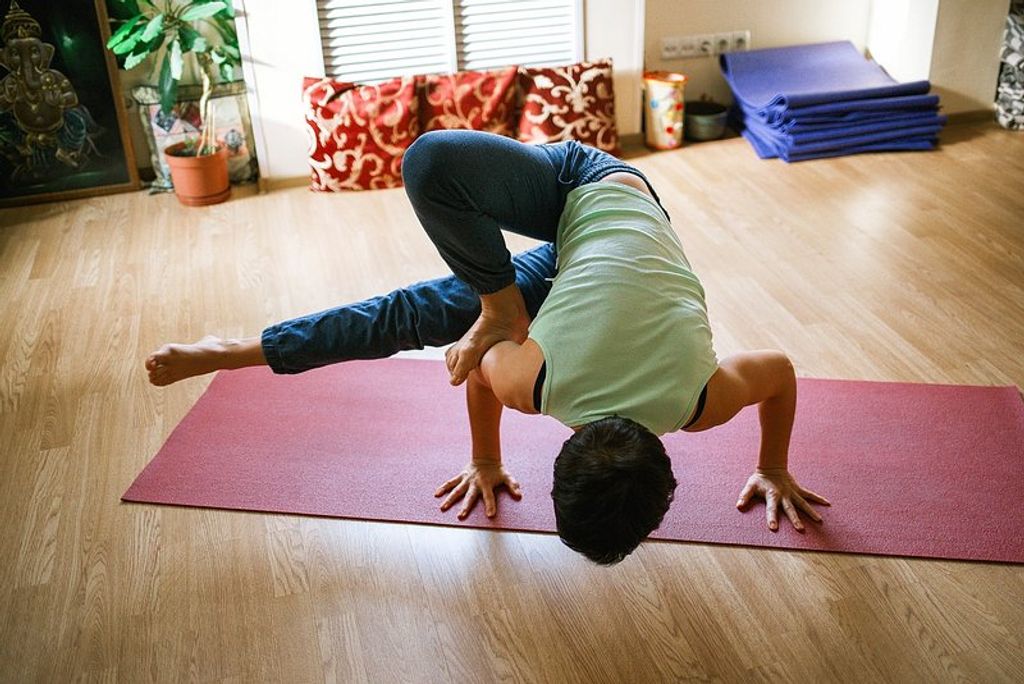
Top Picks for the Best Yoga Mats of the Year
Choosing the right yoga mat is essential for a comfortable and effective practice. With so many options available, it's important to consider your practice style, the material and texture of the mat, as well as its thickness and cushioning. Additionally, eco-friendly and hot yoga-specific mats offer unique benefits that cater to specific needs. Here are the key takeaways from each category:
Key Takeaways
- Consider your practice style when choosing a yoga mat.
- The material and texture of the yoga mat play a crucial role in comfort and grip.
- Thickness and cushioning are important factors to consider for joint support and stability.
- Natural rubber, cork, and recycled materials are eco-friendly options for yoga mats.
- Non-slip, absorbent, and heat-resistant mats are ideal for hot yoga practices.
Choosing the Right Yoga Mat
Consider Your Practice Style
Selecting the ideal yoga mat is a personal journey that aligns with your individual practice style. Different yoga disciplines require varying levels of grip, cushioning, and space. For instance, a Vinyasa practitioner might prioritize a mat with superior grip to accommodate dynamic movements, while someone who enjoys Restorative yoga may opt for extra cushioning for prolonged poses.
- Vinyasa: Grip and size
- Restorative: Cushioning and comfort
- Ashtanga: Durability and stability
It's essential to reflect on the type of yoga you practice most frequently. This introspection ensures that the mat you choose enhances your experience rather than detracts from it.
Remember, the perfect yoga mat can vary widely among yogis. As highlighted by GearLab's extensive testing, there's no one-size-fits-all solution. The key is to find a mat that feels like an extension of your practice, supporting your movements and providing the necessary comfort.
Material and Texture
The material and texture of your yoga mat can greatly influence your practice. Choosing the right one is essential for comfort and stability. Most mats are made from PVC, which offers durability and stickiness, but eco-conscious yogis might prefer mats made from natural rubber or TPE, which are biodegradable and often more sustainable.
- PVC (Polyvinyl Chloride): Durable, sticky, affordable
- Natural Rubber: Eco-friendly, good grip, may cause allergies
- TPE (Thermoplastic Elastomer): Eco-friendly, lightweight, less durable
When considering texture, think about the grip and how it feels against your skin. A too smooth surface can lead to slipping, while a too rough texture might be uncomfortable during longer sessions.
Remember, the best yoga mat for you should align with your personal practice and ethical preferences. Reviews, such as those from Wirecutter, often highlight popular choices like the Lululemon The Mat 5mm and the JadeYoga Harmony Mat, which offer a balance of comfort and support.
Thickness and Cushioning
When selecting a yoga mat, the thickness and cushioning are crucial for comfort and support. A mat that's too thin can be hard on your knees and joints, while one that's too thick may affect your stability during poses. It's important to find the right balance that suits your body and the type of yoga you practice.
Thickness varies typically from a thin travel-friendly 1/16 inch to a plush 1/4 inch. Consider how much space you have for storage and whether you'll be carrying the mat to classes.
- 1/16 inch (1.5mm): Ultra-thin, travel-friendly
- 1/8 inch (3mm): Standard thickness, good for balance
- 1/4 inch (6mm): Extra cushioning, ideal for restorative practices
The right cushioning can make a significant difference in your practice, providing the necessary support to enhance your yoga experience.
Remember, a good yoga mat can be a valuable companion on your journey to relaxation, stress management, and self-discovery. As you reconnect with yourself, consider the impact of your choices on the environment and explore eco-friendly options available at retailers like Yune Yoga.
Eco-Friendly Yoga Mats
Natural Rubber Mats
When it comes to eco-friendly options, natural rubber yoga mats are a top choice for many practitioners. They offer excellent grip and durability, making them suitable for various styles of yoga. Natural rubber is also known for its cushioning properties, providing comfort without compromising stability.
Eco-conscious yogis will appreciate that natural rubber mats are made from a renewable resource and are often biodegradable. However, it's important to check if the mat is made from pure natural rubber or if it's blended with synthetic materials, as this can affect both the mat's performance and its environmental impact.
While natural rubber mats are generally more expensive than synthetic options, their longevity and eco-friendliness justify the investment for many.
Here are some key considerations when choosing a natural rubber yoga mat:
- Grip and texture
- Cushioning and support
- Environmental impact
- Price and brand reputation
Remember, a good yoga mat is like a one-stop shop for your practice, providing the foundation for all your movements and flows.
Cork Yoga Mats
Cork yoga mats are gaining popularity among eco-conscious yogis. The natural properties of cork provide a unique combination of comfort, durability, and grip. Cork is naturally antimicrobial, which helps to repel bacteria and odors, making it an excellent choice for those who prioritize cleanliness.
Eco-friendliness is a significant advantage of cork mats. They are made from the bark of cork oak trees, which regenerates over time, ensuring that no trees are harmed in the process. Cork mats are also biodegradable and recyclable, contributing to a more sustainable practice.
Cork yoga mats offer a perfect balance between firmness and elasticity, which can enhance your practice by providing the support needed for balance poses.
Here's a quick comparison of cork mats to other eco-friendly options:
- Cork Mats: Antimicrobial, excellent grip, sustainable
- Natural Rubber Mats: Highly cushioned, good grip, sustainable
- Recycled Material Mats: Varies by product, often less durable
When considering a cork yoga mat, remember that they can vary in thickness and texture. Some may prefer a thicker mat for additional cushioning, while others might choose a thinner mat for better stability.
Recycled Materials
Yoga mats made from recycled materials are not just a trend; they are a testament to the sustainable practices that can be integrated into our fitness routines. Using recycled materials to create yoga mats offers several benefits. Recycling materials such as rubber or plastic helps reduce waste and conserves resources, making these mats an excellent choice for environmentally conscious yogis.
Recycled yoga mats come in various forms, often utilizing post-consumer waste that is transformed into durable and supportive mats. These mats can be just as high-quality as their non-recycled counterparts, providing the same level of comfort and stability needed for a rigorous yoga practice.
When choosing a recycled yoga mat, consider not only the environmental impact but also the mat's performance and lifespan.
Here are a few popular types of recycled materials used in yoga mats:
- Recycled rubber
- Recycled TPE (Thermoplastic Elastomer)
- Recycled EVA (Ethylene Vinyl Acetate)
By opting for a mat made from recycled materials, you're contributing to a reduced carbon footprint and supporting the recycling industry. It's a meaningful way to align your yoga practice with your values.
Yoga Mats for Hot Yoga
Non-Slip Mats
When practicing hot yoga, a non-slip surface is crucial to maintain stability and safety during poses. The best non-slip yoga mats offer a superior grip that enhances your practice by allowing you to hold poses longer without slipping, even as you sweat.
Durability is another important factor for non-slip mats, as frequent exposure to sweat and moisture can wear down a mat more quickly. Look for mats that are specifically designed to withstand the rigors of hot yoga.
- Superior grip for stability
- Enhanced durability for longevity
- Materials designed for moisture resistance
The right non-slip yoga mat can transform your hot yoga experience, providing the confidence to push your limits.
In light of recent reviews, such as the one from Verywell Fit which highlights the Alo Yoga's Warrior Mat for its high-quality design, it's evident that investing in a top-tier non-slip mat is a wise choice for any hot yoga enthusiast.
Absorbent Materials
When practicing hot yoga, the ability to manage sweat is crucial. Absorbent materials are key in maintaining a safe and slip-free surface. Many yoga mats designed for hot yoga come with microfiber surfaces or have a towel-like layer on top, which can soak up moisture effectively.
Microfiber mats, in particular, offer a high level of absorbency, ensuring that even during the most intense sessions, the grip remains consistent. It's important to consider the washing instructions for these mats, as regular cleaning is essential for hygiene and to maintain the mat's absorbency.
The right absorbent material can greatly enhance your hot yoga experience, providing comfort and stability throughout your practice.
Here's a quick list of features to look for in an absorbent yoga mat:
- Quick-drying surface
- Easy-to-clean materials
- Antimicrobial properties to prevent odor
- Adequate grip when wet
Heat-Resistant Mats
When practicing hot yoga, a mat that can withstand high temperatures is crucial. Heat-resistant yoga mats are designed to maintain their integrity and grip, even as studio temperatures soar. These mats often feature materials that are less likely to degrade or become slippery when exposed to sweat and heat.
Durability is a key factor when selecting a heat-resistant mat. Look for mats that specify resistance to UV rays and high temperatures. Below is a list of features to consider when shopping for a heat-resistant yoga mat:
- High melting point materials
- UV resistance
- Stability in hot environments
Remember, a good heat-resistant mat should not only survive the heat but also support your practice by staying flat and grippy.
It's important to note that while heat resistance is a valuable feature, it should not come at the expense of other essential qualities such as cushioning and support. Always balance your needs to find the perfect mat for your hot yoga sessions.
Conclusion
In conclusion, the best yoga mats of the year offer a perfect balance of comfort, durability, and eco-friendliness. Whether you're a beginner or an experienced yogi, investing in a high-quality yoga mat can significantly enhance your practice. With a wide range of options available, there's a perfect yoga mat out there for everyone. Choose one that suits your needs and enjoy a more fulfilling yoga experience.
Frequently Asked Questions
How do I choose the right yoga mat for my practice style?
Consider the type of yoga you practice and the level of intensity. For example, if you practice a more vigorous style like hot yoga, you may need a non-slip mat with good grip. If you do gentle or restorative yoga, you may prefer a thicker, more cushioned mat.
What are the benefits of eco-friendly yoga mats?
Eco-friendly yoga mats are made from sustainable materials that are better for the environment. They also tend to be more durable and provide good grip, making them a popular choice for environmentally conscious yogis.
Are natural rubber mats suitable for hot yoga?
Yes, natural rubber mats are a great choice for hot yoga as they offer excellent grip even when wet. They are also durable and provide cushioning for intense practices.
What makes cork yoga mats eco-friendly?
Cork yoga mats are eco-friendly because cork is a sustainable and renewable material. Cork also has natural antimicrobial properties, making it a hygienic choice for yoga practice.
How do I choose a non-slip mat for hot yoga?
Look for a mat with a textured surface that provides good grip, even when wet. Some non-slip mats are designed specifically for hot yoga and are made from materials that become grippier as they get wet.
What are the benefits of using heat-resistant yoga mats for hot yoga?
Heat-resistant yoga mats are designed to withstand the high temperatures and humidity of hot yoga practice. They provide a stable and non-slip surface, ensuring safety and comfort during intense sessions.


